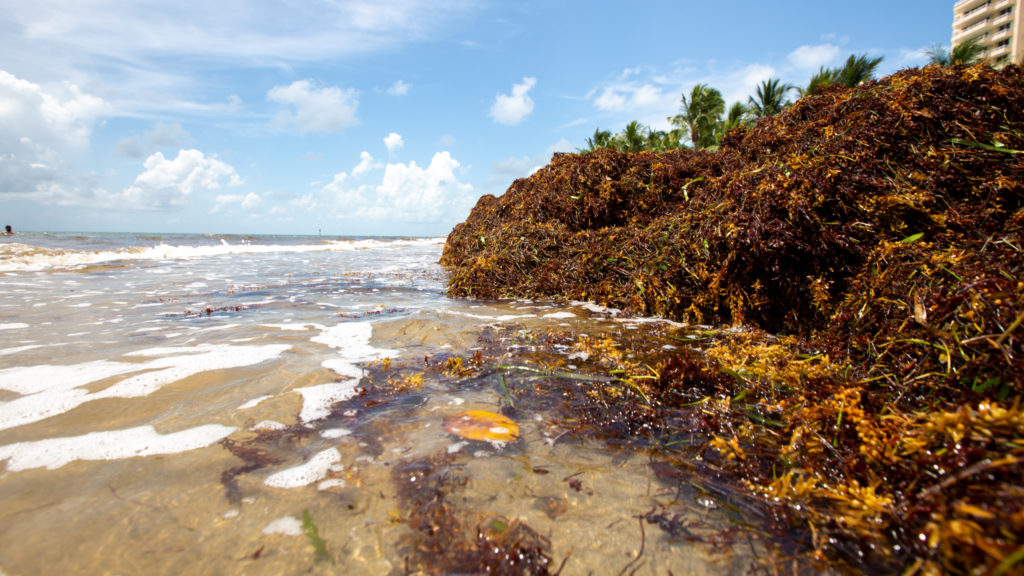Sick Sand: Bacteria Counts Surge on Beach
Tony WintonAugust 5, 2019

Sargassum seaweed sits in a two-foot-high clump along the Atlantic Ocean beach in Key Biscayne, July 18, 2019. New data in Key Biscayne is showing increasing levels of fecal bacteria in the sargassum along island beaches, as governments around the world struggle to deal with increasing amounts floating ashore. (Key News/Tony Winton)
Millions of pounds of seaweed have made Key Biscayne’s beaches smelly and unsightly. But new data from bacterial testing of sargassum is showing the sand itself is getting sick, too.
Literally sick, as in having rising concentrations of fecal bacteria that experts say beachgoers should avoid.
“I would recommend that children wash their hands and leave the beach if they get cut,” said Helena Solo-Gabriele, a professor of civil and environmental engineering at the University of Miami who described her research at a sargassum conference this week.
“Don’t go to the beach if you have a deep cut,” she cautions. “If you eat at the beach, wash your hands or use a handwipe.”
The reason, she said, is concentrations of enterococci have been increasing in the sand. Researchers have been measuring the bacterial counts at various distances from the waterline, including areas where the Village of Key Biscayne has plowed sargassum back into the sand.
“The levels of bacteria in the seaweed have been increasing significantly,” she said.
Samir Elmir, the director of environmental health for the Florida Department of Health in Miami-Dade County, said staying away from sargassum is good advice.
“Even healthy people, this is not something you want to wade in and play with,” he said.
The concentrations have been increasing all summer, Solo-Gabriele said, and the current thinking is the massive seaweed clumps might provide an incubation zone. Bacteria normally is weakened by sunlight, but sargassum gives bacteria a place to grow, she said. Higher summer temperatures, along with drier seaweed, also seem to be playing a role.
In the ocean, the sargassum typically does not have the bacteria. It can acquire the bacteria from human and animal waste as it floats toward shore.
In Key Biscayne, some have questioned whether the County water treatment plant on neighboring Virginia Key is a main contributing factor. But Solo-Gabriele says that while research is ongoing, the evidence — so far — does not suggest a connection.
“I don’t expect to see correlations,” she said.
Instead, she said, the evidence seems to point to contamination happening close to shore.
The bacterial problem is just part of the many difficult challenges facing governments around the globe about the explosion of sargassum, believed caused by excess nutrients flowing into the ocean from South America and Africa.
One solution is hauling the sargassum away, and that’s what Miami-Dade County has elected to do, ramping up removal. In some Mexican tourist areas, officials are permitting resorts to install anchored water barriers to prevent the seaweed from washing ashore, using boats to remove sargassum before it lands.
But the barrier technique, for now, has been rejected by Miami-Dade County officials, according to a memo from Commissioner Eileen Higgins.
But using trucks to remove sargassum from sand could cause other problems, according to Valentina Caccia, an oceanographer at Nova Southeastern University. She is doing testing on chemical pollutants, such as toxic metals, that sargassum might be bringing ashore.
She says simply disposing of sargassum without knowing its chemical composition could pose risks to beach workers and could limit mitigation strategies such as finding commercial uses for sargassum. Ideas have ranged from making everything from bricks to biofuel from seaweed.
“We need to learn lessons from other countries and do it better,” she said.
In Key Biscayne, officials have been investigating composting solutions for sargassum instead of plowing it back into the sand.
Solo-Gabriele, the University of Miami scientist, says as sargassum quantities increase, plowing it back into the sand might not be the best method.
“I think there is a limit as to what the sand can assimilate,” she said.



Responses
Bolsonaro Sends Army to Fight Huge Fires in the Amazon – Key News
Aug 24
[…] has piled up on Key Biscayne and other Miami beaches and researchers say it’s contributing to increased fecal bacteria levels being detected in beach sand. Officials are coming up with ways to deal with the seaweed. […]
The comments are closed.